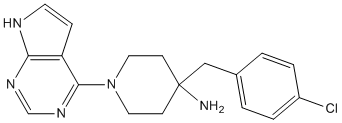All AbMole products are for research use only, cannot be used for human consumption.

CCT128930 is a novel potent ATP-competitive, AKT inhibitor with an IC50 of 6 nM. CCT128930 prevents AKT activity in vitro and in vivo and induces marked antitumor responses. CCT128930 showed significantly antiproliferative activity and inhibited the phosphorylation of a range of AKT substrates in multiple tumor cell lines in vitro, consistent with AKT inhibition. CCT128930 caused a G1 arrest in PTEN-null U87MG human glioblastoma cells, in? good agreement with AKT pathway blockade.
| Cell Experiment | |
|---|---|
| Cell lines | U87MG, LNCaP and PC3 cells |
| Preparation method | Cells are seeded in 96-well plates and allowed to attach for 36 hours to ensure exponential growth prior to treatment. In vitro antiproliferative activity is determined using a 96-hour SRB assay. TCA-fixed cells are stained for 30 minutes with 0.4% (wt/vol) SRB dissolved in 1% acetic acid. At the end of the staining period, SRB is removed and cultures are quickly rinsed four times with 1% acetic acid to remove unbound dye. The acetic acid is poured directly into the culture wells from a beaker. This procedure permits rinsing to be performed quickly so that desorption of protein-bound dye does not occur. Residual wash solution is removed by sharply flicking plates over a sink, which ensures the complete removal of rinsing solution. Because of the strong capillary action in 96-well plates, draining by gravity alone often fails to remove the rinse solution when plates are simply inverted. After being rinsed, the cultures are air dried until no standing moisture is visible. Bound dye is solubilized with 10 mM unbuffered Tris base (pH 10.5) for 5 minutes on a gyratory shaker. OD is read in either a UVmax microtiter plate reader or a Beckman DU-70 spectrophotometer. For maximum sensitivity, OD is measured at 564 nm. Because readings are linear with dye concentrations only below 1.8 OD units, however, suboptimal wavelengths are generally used, so that all samples in an experiment remains within the linear OD range. With most cell lines, wavelengths of approximately 490-530 nm works well for this purpose. |
| Concentrations | 0-18.9 μM |
| Incubation time | 48 hours |
| Animal Experiment | |
|---|---|
| Animal models | PTEN-null U87MG human glioblastoma cells are injected subcutaneously (s.c.) in the right flank of female CrTacNCr-Fox1nu mice. For HER2-positive, PIK3CA-mutant BT474 human breast cancer xenografts, cells are administered s.c. in medium supplemented with M |
| Formulation | CCT128930 is dissolved in 10% DMSO, 5% Tween 20, and 85% saline |
| Dosages | ≤50 mg/kg |
| Administration | Administered via i.p. |
| Molecular Weight | 341.84 |
| Formula | C18H20ClN5 |
| CAS Number | 885499-61-6 |
| Solubility (25°C) | DMSO 60 mg/mL |
| Storage |
Powder -20°C 3 years ; 4°C 2 years In solvent -80°C 6 months ; -20°C 1 month |
[1] Ziyue Guan, et al. CCT128930 is a novel and potent antagonist of TRPM7 channel
| Related Akt Products |
|---|
| ZINC00784494
ZINC00784494 is a specific Lipocalin-2 (LCN2) inhibitor. ZINC00784494 inhibits cell proliferation, cell viability and reduces AKT phosphorylation levels in SUM149 cells. |
| (E)-Akt inhibitor-IV
(E)-Akt inhibitor-IV is a PI3K-Akt inhibitor, with potent cytotoxic. |
| K-80003
K-80003 is a potent inhibitor of tRXRα-dependent Akt activation and cancer cell growth. |
| FPA-124
FPA-124, a cell-permeable copper complex, is a selective Akt inhibitor with an IC50 of 0.1 μM. |
| SPOP-IN-1
SPOP-IN-1 is a selective SPOP E3 ubiquitin ligase inhibitor. |
All AbMole products are for research use only, cannot be used for human consumption or veterinary use. We do not provide products or services to individuals. Please comply with the intended use and do not use AbMole products for any other purpose.


Products are for research use only. Not for human use. We do not sell to patients.
© Copyright 2010-2024 AbMole BioScience. All Rights Reserved.
